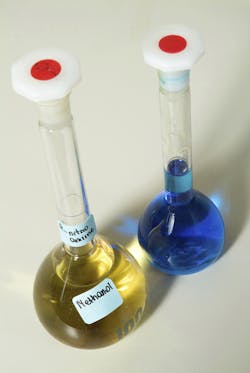Imagine powering your laptop computer or cell phone with alcohol? This idea might not be so far-fetched, as a number of organizations are already actively developing methanol-powered fuel cells for electronic devices, according to a newly published paper in MRS Energy & Sustainability—A Review Journal, published by The Materials Research Society. In fact, forecasts highlighted in the paper indicate that the market for methanol fuel cells may reach $1.1 billion by next year.
The paper by a group of scientists from the Colorado School of Mines provides an overview of recent research in this area. The authors examine the technological, environmental, and policy aspects of direct methanol fuel cells (DMFCs), which convert the energy stored in liquid methanol fuel to electrical energy.
As a sustainable alternative to fossil fuels, fuel cells based on potentially renewable fuels, such as hydrogen and methanol, have received considerable scientific attention. The authors report that the attractive properties of methanol in terms of its energy density, ease of distribution, and potential for production from clean fossil-based resources (natural gas) or from renewable fuel sources (biomass, solar) make the DMFC an appealing power technology that may eventually be used as a renewable fuel source for the transportation sector.
Methanol fuel is less expensive (per unit energy) and provides significantly higher volumetric and gravimetric energy density when compared to compressed hydrogen (at 1000 bar) and even liquid hydrogen. Methanol fuel embodies 10 times higher specific energy density than the state-of-the-art Li-ion batteries.
According to author Ryan O’Hayre, Colorado School of Mines, "direct methanol fuel cells are an exciting technology, but there are still a lot of major hurdles to overcome before they can be commercialized."
Based on their overview of current research, the authors conclude that it is more likely that DMFC technology will be commercialized first for small portable power applications because of the relatively high costs involved compared to hydrogen-based fuel cells, as well as durability and power-density issues. They predict that methanol-based renewable fuel cells might replace batteries in consumer electronic applications or laptop batteries in the first instance. In fact, the authors find that a number of organizations are already actively developing DMFCs for portable electronics devices. They draw on marketing forecasts indicating that the DMFC market may reach $1.1 billion by 2016, and account for 85 percent of the portable fuel cell market.
The authors predict that new breakthroughs in DMFC performance—particularly increases in power density and efficiency, coupled with cost reduction—could eventually make methanol-fuelled vehicles a compelling option in future.
The paper by Dr. Prabhuram Joghee, Dr. Jennifer Nekuda Malik, Professor Svitlana Pylypenko and Professor Ryan O’Hayre from Colorado School of Mines is available in MRS Energy & Sustainability—A Review Journal here.


